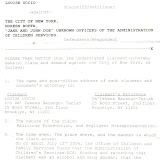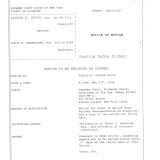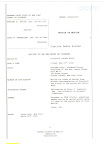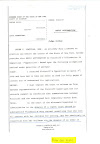It was released online tonight, Friday, instead of waiting for the official publish date this Sunday.
It has video that goes along with the story. You can find the videos and can comment here:
http://www.sptimes.com/2008/02/17/Worldandnation/Deadly_Combinations.shtml
And letters can be sent here: http://www.sptimes.com/letters/
St. Petersburg Times Deadly Combinations The drugs that are killing the most people right now didn't originate on the street, but with a prescription.
By CHRIS TISCH and ABBIE VANSICKLE,
Times staff writers
February 17, 2008
Prescription painkillers and anti-anxiety drugs are killing about 500 people a year in the Tampa Bay area, twice the number killed by illegal drugs such as cocaine and heroin.
Prescription drug overdoses killed 433 people in the bay area in 2006, up from 339 the year before. Though 2007 figures aren't complete, the area is on pace for about 550 deaths. That means prescription drug overdoses are likely to overtake car crashes as the leading cause of accidental death here.
"The numbers are pretty staggering," said Bill Pellan, director of investigations for the Pinellas-Pasco Medical Examiner's Office.
Statewide, prescription drug overdoses caused 1,720 deaths in 2006, up about 40 percent from just three years earlier. In 2007, the state was on a pace of about 2,000 deaths.
That many people would fill almost all the seats in Ruth Eckerd Hall. They would pack 15 Southwest Airlines jets. They would make up the entire student population of Armwood High School in Hillsborough County."There is clearly a lack of understanding across the state of the danger of these drugs," says Bill Janes, director of the Florida Office of Drug Control. "I would have to say it is a health crisis."
But the problem is more severe in the Tampa Bay area, where the number of deaths per capita is nearly 70 percent higher than the state.
Police report a surge in prescription drug-related crimes, including doctor shopping, prescription fraud and pharmacy robbery. Drug rehabilitation centers have treated a wave of prescription drug addicts in recent years. Methadone clinics now treat more people addicted to painkillers than heroin. "This has become an epidemic," says Circuit Judge Dee Anna Farnell, who runs the drug court in Pinellas County. "It was cocaine in the '70s, crack in the '80s. Now it's the abuse of pharmaceuticals."
Who's dying from prescription drug overdoses?
The St. Petersburg Times obtained autopsy records and investigators' reports for each of the 772 deaths caused by prescription drugs in 2005 and 2006 in Hillsborough, Pinellas, Pasco and Hernando counties. The newspaper built a database and discarded 127 cases in which the manner was suicide or undetermined. The Times analyzed the remaining 645 accidental deaths for trends and patterns.
Some findings:
- People in their 40s were the most likely to die from prescription drugs, followed by those in their 20s and 30s. Teens were the fastest-growing group.
- The dead most often held jobs in manual labor, the service industry or the medical field.
- Most died from overdoses of opioid painkillers, natural or synthetic versions of the opium poppy. The painkillers methadone and oxycodone topped the list.
- A large number also died from overdoses of anti-anxiety drugs such as Xanax and Valium.
- Nearly 70 percent died from an overdose of more than one drug.
The Times' analysis shows the dead are a complex group.
Some are chronic drug abusers who operate on society's fringes.
Others are lawyers, doctors, nurses, school teachers, pastors, college kids, cops, soldiers, business owners and soccer moms.
The autopsy room at the Pinellas-Pasco medical examiner's office is spacious, well-lit and chilly. It smells of disinfectant and bleach. Silver cutting tools sit on a counter. A large walk-in refrigerator stands on one side of the room. Inside are several bodies on steel tables, sheets covering everything but feet. Toes point to the ceiling. About 1,800 bodies are wheeled into this autopsy room every year. Many are scarred with signs of traumatic injury from murders, suicides or car accidents.
Over the past few years, however, more and more bodies have arrived with telltale signs of prescription drug abuse. In most cases, the person accidentally took a toxic amount of a painkiller, which suppressed breathing to the point of death. Medical examiner Dr. Jon Thogmartin says fatal prescription overdoses have soared in the seven years he has been on the job. "We'd probably lose about 25 percent of our work if not for prescription drugs," Thogmartin says.
His counterpart across the bay, Hillsborough County medical examiner Dr. Vernard Adams, says his office had to hire an additional medical examiner to handle the increasing deaths from prescription drugs. To determine the cause and manner of death, Thogmartin and his staff review photos taken at each scene. The photos almost always show the dead person lying in a cluttered home. The beds have no sheets. Dirty dishes are piled in the sink. Liquor bottles and rotted food are scattered on spare furnishings.
At the beginning of each autopsy, Thogmartin also notes scars or tattoos on each body. He often finds scars on the back or neck of those who overdosed on prescription drugs. This leads Thogmartin to believe a legitimate injury from a car crash or workplace may have put them on a path to the morgue.
Thogmartin's observations echo the Times' analysis:
- 54 percent of the dead had a history of pain or injury while 36 percent had a history of emotional pain, usually depression. 69 percent had one or the other.
- 80 percent had a substance abuse problem.
- 52 percent had a history of addiction and pain, whether physical or emotional.
Prescription drugs relieved pain but also ended lives.
Sharon Simpson had asked her fiance, Michael Wood, to hide her pills so she wouldn't take them too fast. He stuffed them in a sock drawer in the bedroom of their Pinellas Park apartment. Sharon found them in the wee hours of New Year's Day. Before daybreak, she was dead. Like many who die of prescription drug overdose, Sharon struggled with substance abuse, chronic pain and emotional turmoil. Her father beat her mother. Sharon turned to drugs and alcohol at an early age. She was pregnant by 14, said her sister, Carrie Nelson.
With multiple men, Sharon birthed four children, none of whom she was raising at the time of her death. She worked for a credit card company.
In recent years, Sharon suffered chronic back pain from a fall and a car accident.
She was taking the painkiller hydrocodone and the muscle relaxant Soma. Despite her troubles, Sharon was outgoing and funny. She enjoyed the beach and taking walks.
Hours before she died, the couple had celebrated New Year's Eve at a bowling alley. Sharon had several beers and a glass of champagne as she greeted 2006. Back at home, Sharon found the pills before she went to bed. Minutes after they lay down, Michael heard Sharon snoring and gurgling. He shook her. She vomited but would not wake. An ambulance took her to the hospital, where she was pronounced dead. The medical examiner said she died of an accidental overdose of Soma. Alcohol was a contributing factor. Sharon was 33. Michael says he had feared Sharon might overdose and had talked to her about seeking other ways to treat her pain. Sharon had agreed to do that in the new year.
At the end of the 1990s, cocaine and heroin had a grip on Florida.
Deaths from heroin had doubled since 1995 to more than 200 a year. Cocaine deaths were surging. But in 2000 medical examiners noticed fatal overdoses from prescription drugs began to outpace deaths from cocaine and heroin. From 2003 to 2006, statewide deaths from prescription drugs grew by 40 percent, while heroin deaths shrank dramatically.
Painkiller prescriptions written by doctors also increased.
From 1997 to 2005, retail sales of five leading painkillers doubled in Florida, according to an Associated Press analysis. In St. Petersburg, retail sales of two of the five painkillers increased more than anywhere else in the state. "The drug companies have replaced the Mexican drug lord," says Larry Golbom, a Pinellas pharmacist who hosts a radio show that focuses on prescription drug addiction.
Several factors contributed to the increase in prescriptions and deaths:
- Drug dealers saw new profits in prescription drugs, which are now commonly sold on the street.
- Inattentive physicians have been duped by doctor shoppers; a few doctors have cashed in on the demand for pills by knowingly prescribing to addicts or dealers.
- Advocacy for chronic pain patients increased, pushing more doctors to prescribe narcotics.
- Insurance sometimes won't pay for pain treatment plans, leaving pills as the only option.
Nationwide, more than 15,000 people died from adverse reactions to drug treatment in 2005, though experts say that number likely is low because reporting is voluntary. Most of those deaths were from pain pills.
Prescription drugs also have killed a number of high-profile celebrities recently, including actor Heath Ledger and model Anna Nicole Smith.
On a rainy July morning in 2007, dozens of people gathered near a courthouse in the tiny Appalachian town of Abingdon, Va. Many carried handmade signs with photos of loved ones. One woman held a tiny urn filled with her son's ashes. Most of them had traveled from Florida, many from Tampa Bay. Each had a personal, tragic story about the painkiller OxyContin. Most of them were parents whose children had fatally overdosed on the drug.
Inside the courthouse, a federal judge scolded executives of Purdue Pharma, the drug company that introduced OxyContin in 1995 as a miracle pain reliever. The federal government had lodged criminal charges against the company because, for years, Purdue Pharma downplayed the addiction potential of OxyContin. Doctors nationwide had prescribed it for minor pain and watched as patients got addicted or fatally overdosed. As part of an agreement with prosecutors, the judge fined the company $600-million and three executives an additional $34.5-million for misbranding the drug. It was one of the largest settlements of its kind in U.S. history.
Perhaps no other prescription drug has drawn more ire than OxyContin, which is why so many people traveled hundreds of miles to Abingdon to rebuke Purdue Pharma in court. The drug is a semisynthetic opioid with a slow-release mechanism providing patients hours of pain relief. Many pain patients praise its efficacy and say it has saved lives. But drug abusers learned the slow-release mechanism could be removed by crushing the pills, causing a fast, intense high similar to heroin. OxyContin abuse most infamously ripped through the Appalachians, earning it the nickname Hillbilly Heroin.
Abuse of the drug swept through Florida as well. Since 2001, more than 2,000 Floridians have died of overdoses of oxycodone, the active ingredient in OxyContin and other painkillers like Percocet.
But another drug has killed even more.
Bama Richardson was working toward a pharmacy technician degree when he injured his back in a car crash a few years ago. He feared getting hooked on painkillers like OxyContin, which he had heard about in class. A doctor prescribed him methadone. "My son thought it was a miracle drug," said his mother, Mary Richardson, who lives in Alabama. "He said, 'Mama, it doesn't get me high and I can still work.' "
Known primarily for weaning addicts off heroin, methadone is now more widely used to treat addiction to painkillers. Methadone is an effective painkiller itself. As OxyContin's reputation soured over the past decade, more doctors turned to methadone to treat pain. Prescriptions tripled from 1998 to 2003. It's much cheaper than OxyContin and doesn't provide the fast, dramatic high of other opiates. This is why Bama was happy to get it. In March 2006, after not hearing from her son for several days, Mary Richardson went to his Tampa apartment and found him dead, a victim of methadone overdose. He was 21.
His mother was shocked when she researched the drug online. She learned methadone overtook oxycodone as the leading prescription drug killer in Florida in 2002. It has killed 3,000 Floridians over the past five years.
Unlike some painkillers, methadone stays in a person's body long after its initial effects have worn off - sometimes up to five days. A person taking more methadone or other drugs or alcohol may not realize the methadone is stowed in their body. The combination may lead to overdose. Though methadone doesn't provide a fast high, drug abusers may seek it for the euphoria it causes if mixed with alcohol or drugs like Xanax. Abusers also seek methadone to stave off withdrawal when they run out of dope. If they later obtain other drugs and take them, the combination can lead to overdose. But methadone doesn't just kill junkies. It also kills pain patients, who may take an extra pill or two, ignorant of the risks. Mary Richardson suspects this happened to her son.
Though some doctors are scared to prescribe methadone, others are forced to because insurance policies may not pay for more expensive drugs. Methadone costs pennies per pill compared to dollars for other pain pills. "So if you don't have good health insurance, you get methadone," says Thogmartin, the Pinellas-Pasco medical examiner. "Methadone is cheaper, generic, long-lasting. It's sort of the uninsured person's OxyContin."
The mounting deaths worry people like Marc Kleinman, director of clinical services at the Operation PAR methadone clinic in New Port Richey. On a recent morning, Kleinman's clinic was bustling with young women with children, men who looked like your grandfather and middle-aged people who looked like life had worked them over pretty good. They were there for a cup of orange liquid methadone that staves off withdrawal and cravings. Twenty years ago, 70 percent of the clients were here for heroin addiction. Today, 70 percent come because of prescription drug addiction."A lot of our patients never engaged in heroin, they just became addicted to opiates through pain medication," Kleinman says. But the people overdosing on methadone aren't getting it from clinics: A state drug study found only 17 of the 716 deaths caused by methadone in 2006 were people enrolled at methadone clinics.
The problem, Kleinman says, is that more prescriptions from doctors means more drugs wind up in the wrong hands. Those uneducated about methadone tend to mix it with other drugs. Of the 250 people who died of methadone overdoses in the bay area in 2005 and 2006, only about 20 percent overdosed solely on methadone.
Mixing of drugs is not a problem specific to methadone. More than two-thirds of all Tampa Bay area prescription deaths in 2005 and 2006 were caused by a combination of two or more drugs. Abusers mix drugs to enhance their high or to ease the after effects.
As a group of teenagers in Seminole found out on a cool December night, this is risky behavior. Money was tight and Christmas was coming. Robert Sheats and Lauren Burke needed extra cash. Burke, 26, had a brain tumor and was prescribed fentanyl, a painkiller far more potent than morphine. It's designed for people with severe pain and comes in many forms including - of all things - a lollipop. Sheats gave 30 fentanyl lollipops to Michael Bartlett, whom he knew from the neighborhood. Sheats told Bartlett, 18, to sell the pops to his friends and bring back the money, authorities said. Bartlett sold some lollipops at a Seminole house party thrown by 16-year-old C.J. Civitella and his sister Kristi, 17. Their mother, Karen Kennedy, a single mom, was out that night, authorities said. C.J., a lanky boy with short blond hair, had a history of abusing marijuana and Xanax. He and his sister took Xanax that night. C.J. also sucked on at least one lollipop. Around midnight, C.J.'s sister found him passed out in the bathroom. Friends helped him into bed. Somebody drew vulgar pictures and sayings on his chest and neck with a marker, then pulled a blanket over him. The next morning, C.J.'s sister and her friends checked on him and found his eyes open, his skin purple, his body stiff.
The medical examiner's office ruled his death an accidental overdose of Xanax and fentanyl.
Bartlett, Burke and Sheats were arrested on charges of delivering a controlled substance. Burke and Sheats received three years of probation. Bartlett awaits trial. "We just didn't think right," Burke told a detective in an interview. "We didn't think ... that someone would die."
Kristi and her mother moved in with a woman whose daughter also had died of a prescription drug overdose.Kristi Civitella says she hasn't touched drugs since her brother's death. She recently made a list of young people she knew in the Seminole area who had died of prescription drug overdoses. Including her brother, she counted six. Fourteen teenagers died of accidental prescription drug overdoses in the Tampa Bay area in 2006, up from nine the year before. In the first six months of 2007 alone, the number already had reached 12.
Several studies over the past few years have found that prescription drugs are becoming a favorite among teenagers, prompting some to label today's young people Generation Rx.
More than 70 percent of young people say home medicine cabinets are their source, and more than half believe prescription drugs aren't as dangerous as the street variety, studies show.
Teens gather at "pharm parties" or "skittles parties" where they mix prescription drugs to get high. Sometimes these kinds of gatherings end badly, as they did for C.J. Civitella.
Prescription drugs also are claiming people in their 20s at an increasing rate, with 57 dying in 2005 and 79 in 2006 in the bay area. The area was on pace to lose more than 100 people in their 20s to accidental prescription drug overdoses in 2007. Drug treatment centers report an increase in young people seeking rehab for prescription drug addictions. Some of them started taking drugs to get high, but many were shown at an early age that pills would solve their problems.
"Mom would wake up every day with her orange juice and a bowl of cereal and three pills," says Christopher Neilson, assistant program manager at Goodwill Industries' drug treatment center in St. Petersburg. "And a lot of those kids ... were on hyperactivity medications when they were young, so it's already been conditioned in them that if you can't behave yourself in school, what do you do? I need a pill."
Matt Dorn wrapped gauze under his chin and around his head, then sucked on his gums until they bled. He spit the blood onto his bandages and hobbled into a pharmacy in Pasco County, where 20 waiting customers allowed him to cut to the front of the line. He received a bounty of powerful painkillers with a forged prescription. "If you could win an Emmy for that, I probably would have won an Emmy," Dorn says. Dorn was a prescription drug abuser who snorted and injected dozens of pills per day. The drugs didn't kill him, but they did ruin his life.
The funny, fast-talking 25-year-old grew up in a happy family in a nice subdivision in Port Richey. His father worked in construction, his mother in the title business.
At age 15, Dorn hurt his ankle in football. Dorn said his parents gave him a Vicodin, which his father had taken for a work injury. The pills made him feel good. "It was love at first sight," Dorn recalls. "You have no fear, no doubts, no negativity." Dorn doesn't blame his parents. He would have tried pills eventually. They were all over his high school. "Crack is real dirty and no one wants to do it and heroin is real dirty and no one wants to do it," Dorn says. "But pills? If your parents are doing it and everybody's doing it, then it's okay." He built a tolerance to the pills and needed more. By 18, he was waking up "dope sick" every morning. To stave off body aches and vomiting, he started his days with 10 Vicodins. Then he made the jump to powerful OxyContins. His tolerance soared. His morning sickness deepened. Dorn needed 10 80-milligram OxyContins just to make it through the day. "You can't do anything until you get that fix," Dorn says. "And that's where you start doing crazy stuff." That included pawning tools from his dad's garage and electronics he stole from stores. The pills led him to crack cocaine, which he sold to buy more pills. "I was chasing (pills) every day. That's all I did for 3 1/2 to four years is chasing," Dorn says. "I couldn't have a good day unless I had a good amount of oxies."
At one point, Dorn bought two sheets from a stolen prescription pad. He made copies, picked names from the phone book and faked Social Security numbers to call in bogus prescriptions. He even took a pharmacy technician class at a community college, where he hoped to learn a few tricks. His run ended when he turned to leave a pharmacy one day and three cops were waiting. He was charged with drug trafficking. Dorn stayed in jail for about six months.
The first few weeks without drugs he endured muscle spasms, vomiting, body aches, cramps, dry heaving, defecating on himself. Dorn took a deal with prosecutors that got him five years of drug offender probation, including more than a year of residential drug treatment at Operation PAR in Largo. He was released in December 2006 and says he has been clean since. He doesn't miss the scene. "There's professional doctor shoppers, people who have contacts in pharmacies and doctors' offices who sell. People who steal pads. They wash scripts and hang them out to dry like in a photo lab. They make them on a computer.
"It's a whole corrupt little underworld."
Debbie Curry, 52, flips through family photos of her daughter. She can tell which ones were taken when Marissa was abusing prescription drugs. "The eyes always told me," Debbie says. "Look. She's got that zoned-out look. We don't keep a lot of those pictures around." Debbie's insight about prescription drugs isn't limited to her daughter's blue eyes. The Seminole mortgage broker suffers from chronic back pain, so she understands prescription drugs from two sides: they can enrich life by relieving pain, but they also can summon death. Marissa abused prescription drugs after she was injured in a car accident in 2000. That led to heroin abuse, several near-fatal overdoses, an arrest, 18 months in drug treatment and, finally, sobriety. But a second car accident caused more neck and back pain. She went to a doctor, who wrote a prescription for 120 painkillers called Lortab. Debbie thinks Marissa took some of those pills and sold the rest to buy heroin. The next morning, Marissa's boyfriend found her dead in bed at a St. Petersburg hotel. She was 24. Blood tests showed she overdosed on two kinds of painkillers and heroin. Alcohol, marijuana and two anti-anxiety drugs also were in her system.
Despite her daughter's death, Debbie Curry believes prescription narcotics should be available for pain patients who need them. She says doctors must be more vigilant about keeping them from addicts. "It was like giving her a loaded gun," Debbie says. "If you're an addict, you can take one pill and you might as well go back to Square One. There has to be some kind of a system. A happy medium somewhere. I just don't know where it is." Every night, Debbie takes the painkiller Percocet, which dulls her pain and helps her get to bed.
She falls asleep next to Marissa's ashes.























No comments:
Post a Comment